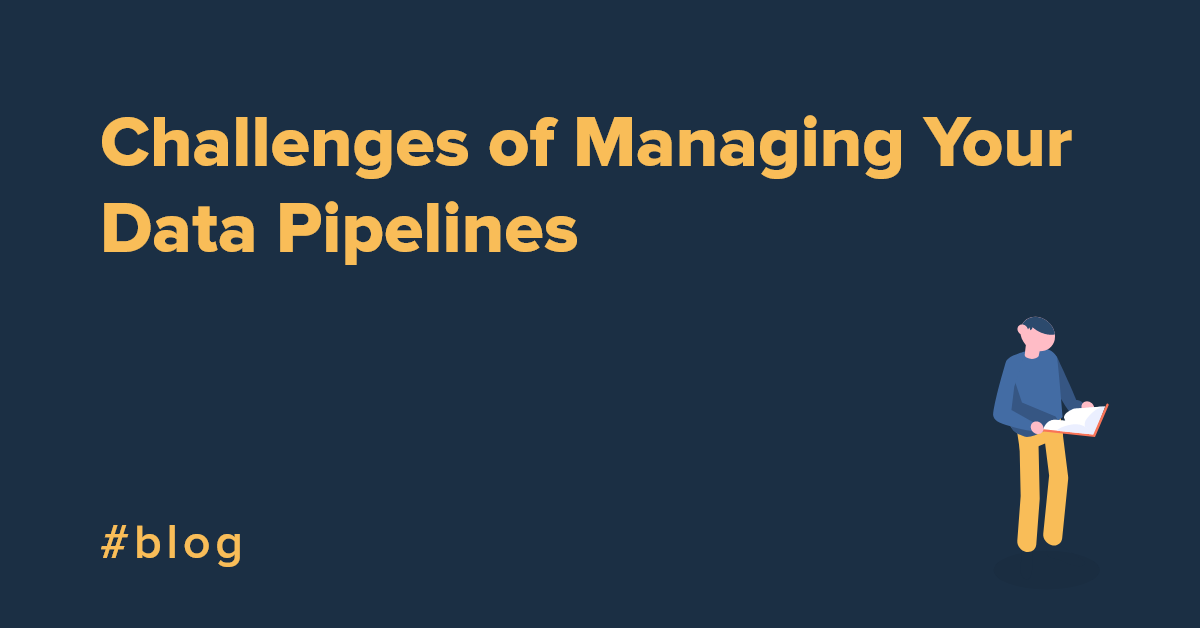In this era of ever-more stringent data regulations, knowing, understanding and managing your data throughout its lifecycle is more important than ever. It’s also harder than ever, as data volumes grow and data pipelines become more complex.
At enterprise scale, the key to more control and transparency is automating as much of your process as possible.
If any of the problems below sound familiar to you, check out the webinar to find out how to make modern management of data pipelines easier, from data discovery, classification and cataloging to data governance and anonymization.
Before we go any further, let's look at a quick definition to make sure we're on the same page. Here's a definition of data pipelines:
What is a data pipeline? (a definition)
A data pipeline is a set of processes performed by a piece of software that moves data from one system to another. It might also transform the data. It can be performed in realtime or in batches.
Now, let's look at the biggest challenges that can hold back your data pipelines.
Enterprise Data Pipeline Management Challenges
1. You’re working with a lot of data sources
Enterprise organizations often have sprawling webs of data sources, with applications that are constantly evolving.
Try a little experiment - count up all the data integrations and paths you think you’re working with. Chances are the number grows quicker than you thought, right? Who manages all those? Who understands all of those? (And what happens if that person leaves?)
Managing all these sources and the complex, large-scale processes that come with them is hard, and being able to document everything in a way that satisfies auditors or regulators (as well as making it clear for different people across the organization) can be a daunting proposition.
2. It’s almost impossible to know what’s really in your data
You might think you know what your data contains and what is happening to it, but at enterprise scale, it’s almost impossible.
Different departments don’t always share plans, architectures or applications, so quite often there’s no comprehensive organization-wide view.
Identifying, understanding and classifying your data wherever it sits - especially as it becomes ever more important to properly manage your PII (Personally Identifiable Information) - is no small task.
And just because you have a field in your data called “Last Name”, there’s no guarantee that that’s actually what’s in there. Finding PII becomes incredibly difficult when you stop assuming that all of your credit card numbers really exist only in the “Credit Card Numbers” field (and not for example in a “Notes” field that someone’s added to a record). When you have huge amounts of data, finding and managing this manually isn’t an option, but it's essential to protect data privacy and minimize risk.
3. Each data consumer in your organization is working with the data independently
When many different people across your organization are working with your data in different ways, for different purposes, it inevitably leads to a lack of standardization.
How to build failsafe data pipelinesData consumers are often creating point-to-point connections to get the data they need, and often performing the same transformations on a dataset again and again in order to use it. And when this is repeated across individuals, teams and departments, you’re looking at a serious duplication of effort.
This also has implications for transparency and auditability. When there’s no single place for data definitions and no single view of where the data has come from, what happens to it and where it ends up, you can’t get a consistent, organization-wide view of all your data pipelines.
4. Protecting sensitive information creates problems
As well as having different data requirements, every consumer in your organization is also likely to have different access permissions - you might not want everyone to have access to sensitive or personal information, and you’ll probably have restrictions on how this data can be worked on or shared.
You could anonymize your datasets across the board, but that comes with its own drawbacks - namely, you could be losing information that may be important for analysis or testing.
5. Reconciliation is difficult, time-consuming and inaccurate
Those multiple point-to-point data connections also create problems when it comes to reconciliation.
If you have a single connection between two systems, you often end up just comparing the data in those two systems against each other. Getting an accurate top-level, organization-wide reconciliation can take a huge amount of time and effort in order to satisfy data governance and regulatory requirements.
6. Translating your data models into executable code is slow and inefficient
Once you’ve captured what and where your data is you'll want to do something with it.
Your data models are where your data definitions are captured and made available to everyone, but they can be just a form of documentation. There can be a big gap between what’s in your data models and what is running in production.
Taking those models and developing runnable transformations and pipelines from them has historically been a slow, expensive and error-prone process. It often requires teams of developers manually creating executable code to run in production, and the link between the ‘data owners’ (the business analysts and stakeholders who work on the data models) and the teams building runtime processes can be ad-hoc and opaque.
There’s no guarantee that what’s in the data model is exactly what ends up in production. There’s no single definition of sources and consumers, no transparency of the process and - crucially for heavily-regulated industries - no single point of control and governance.
Making managing data pipelines easier
Manual and inconsistent data pipeline management is not only hard and error-prone, but it makes life more difficult when it comes to meeting regulatory and audit requirements.
Automating as much of the data lifecycle as possible can help mitigate many of the traditional challenges of managing data pipelines.
Data discovery and classification can be made more accurate and efficient by automatically crawling all your data, wherever it sits, and using matching algorithms to help you figure out what data is really where (and not just what you believe).
Data anonymization engines can integrate with your data pipelines to generate anonymized data based on specified rules.
Getting data models into production can be automated, drastically shortening the development process and improving the visibility of the process and your data pipelines.
Watch the webinar on-demand now to find out exactly how all of the above can help you be much more transparent, meet regulatory and audit requirements more effectively, and make managing your data pipelines easier.
By CloverDX
CloverDX is a comprehensive data integration platform that enables organizations to build robust, engineering-led, ETL pipelines, automate data workflows, and manage enterprise data operations.












